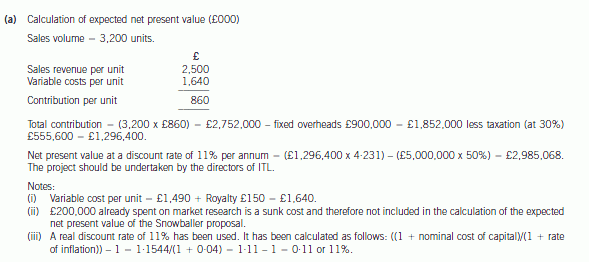ACCA考点解析:Revaluation
发布时间:2021-05-29
ACCA考试在即,备考的小伙伴们有在认真学习吗?为了帮助大家更好的备考,下面51题库考试学习网带领大家一起来看看,关于如何理解ACCA考试中的Revaluation的内容,想要了解的小伙伴赶紧来围观吧。
Revaluation重估是 PPE 后续计量中重要的知识点,在ACCAFA 和 FR考试科目当中都常考。对于 PPE,
Depreciation per annual = Depreciation rate * Net book value
Dr. Depreciation expense
Cr. Accumulated depreciation
除了正常的折旧以外,在日常生活中 以及考试中还会遇到的问题就是重估增值,意思是在经营过程当中,企业可以请专业人士对 PPE 进行估价,看其现在的市值或是公允价值是否与账上体现的净值相等,在这个千变万化的社会,资产的价值是很有可能发生巨大变化的,所以当重估后发现,某一 PPE 的市场价值要高于其现在列示在资产负债表上的净值时,该资产就发生了重估增值。在具体题中,资产账面净值可能需要考生自己算,一般就是用历史成本减去累计折旧,但是市场价值或是公允价值都是直接给出,需要考生做的是,首先比较题中给出的公允价值与账面净值,若发生了重估增值,则要做分录进行记录:
Dr. PPE-cost (Revalued amount – original cost)
Accumulated Dep’n (Total dep’n to date)
Cr. Revaluation reserve (Revalued amount – NBV)
可以看出,在进行重估增值发生后,该 PPE 之前所有的累计折旧都要被冲销掉,PPE 的账面价值变成重估的价值且没有累计折旧,并在重估后重新开始进行折旧。
Revaluation reserve/surplus 可以翻译为重估储备,是考生常常不能透彻理解的一个科目。首先要明白它是一个资产负债表类科目,权益类的,应在 Equity下列示。其次,需要知道它是一种未实现利润,与留存收益不同。这一概念比较好理解,一个固定资产的价值升高,但是它如果继续作为生产工具,像原来一样继续工作,那升高的价值其实没有什么实际意义,只是账面价值升高了而已,你无法因为升值拿到真金白银,有一个比较直接的使升值得以实现的方式,就是把该资产卖掉,但是一般情况下 PPE 是用于正常的生产经营,卖掉会影响生产,因此大部分情况下 PPE 升值后并不会被卖掉以获得收益。所以在重估刚发生时,revaluation reserve 作为一类 equity 列示在资产负债表上,要与 retained earning分开,因为它还没有被实现,不能在之后需要资金如分发股利时直接使用,。 在 revaluation reserve 初始值确定之后,会计的工作并没有完成,该项目不能一直放在资产负债表中不动,因为重估增值部分还有另外一种实现方式:折旧。
PPE 在重估后要重新开始计算折旧金额,cost 升高必然导致每年的折旧额升高,折旧额从重估前到重估后升高的这一变化,便是资产重估增值部分被实现的体现,因为若资产增值的部分没实现,它的损耗不可能凭空增加。因此,通过重估后资产的折旧,revaluation reserve 每年被实现一部分,这一现象要通过分录来反映:
Dr. Revaluation reserve
Cr. Retained earning
数值即为重估后每年的折旧额减去重估前每年的折旧额通 (Excess depreciation)。过分录可以看出,revaluation 逐年转入 retained earning,即成为已实现利润。
在考试中,遇到重估问题,在重估后继续折旧时一定不要忘记处理 revaluation 的转移问题,除非题中表明要忽略 excess depreciation 的问题。
以上是本次51题库考试学习网带给大家的全部内容,相信小伙伴们都了解了。如果想要了解更多关于ACCA考试的资讯,敬请关注51题库考试学习网!
下面小编为大家准备了 ACCA考试 的相关考题,供大家学习参考。
2 Ice-Time Ltd (ITL) manufactures a range of sports equipment used in a variety of winter-sports in Snowland.
Development engineers within ITL have recently developed a prototype of a small engine-propelled bobsleigh named
the ‘Snowballer’, which has been designed for use by young children. The directors of ITL recently spent £200,000
on market research, the findings of which led them to believe that a market exists for the Snowballer.
The marketing director has suggested that ITL should use the ‘Olympic’ brand in order to market the Snowballer.
The finance director of ITL has gathered relevant information and prepared the following evaluation relating to the
proposed manufacture and sale of the Snowballer.
(1) Sales are expected to be 3,200 units per annum at a selling price of £2,500 per unit.
(2) Variable material, labour, and overhead costs are estimated at £1,490 per unit.
(3) In addition, a royalty of £150 per unit would be payable to Olympic plc, for the use of their brand name.
(4) Fixed overheads are estimated at £900,000 per annum. These overheads cannot be avoided until the end of the
year in which the Snowballer is withdrawn from the market.
(5) An initial investment of £5 million would be required. A government grant equal to 50% of the initial investment
would be received on the date the investment is made. However, because the Snowballer would be classified as
a luxury good, no tax allowances would be available on this initial investment. The estimated life cycle of the
Snowballer is six years.
(6) Corporation tax at the rate of 30% per annum is payable in the year in which profit occurs.
(7) All cash flows are stated in current prices and, with the exception of the initial investment and the government
grant, will occur at the end of each year.
(8) The nominal cost of capital is 15·44%. Annual inflation during the period is expected to amount to 4%.
Required:
(a) Calculate the net present value (NPV) of the Snowballer proposal and recommend whether it should be
undertaken by the directors of ITL. (4 marks)

(ii) how effective delegation might be achieved; (6 marks)
(ii) Effective delegation can be achieved by assigning agreed tasks to the subordinate, ensuring that resources are allocated and by specifying expected performance levels and ensuring that they are understood. In addition, it is necessary to ensure that the subordinate has the ability and experience to undertake the tasks by maintaining frequent contact and ensuring that the subordinate has authority to do the job. Sufficient authority must be delegated to fulfil the task. This authority in turn may be specific or general; the scenario suggests that the authority of the managers and supervisors is specific. The subordinate should not refer decisions upwards, and the superior should not expect this. In addition there should be no doubts over boundaries; they must be clearly defined as to who holds what authority and who accounts to whom. Therefore there must be clarity as to departmental functions and individual authority, which is at the root of the problem at Flavours Fine Foods.
C Co uses material B, which has a current market price of $0·80 per kg. In a linear program, where the objective is to maximise profit, the shadow price of material B is $2 per kg. The following statements have been made:
(i) Contribution will be increased by $2 for each additional kg of material B purchased at the current market price
(ii) The maximum price which should be paid for an additional kg of material B is $2
(iii) Contribution will be increased by $1·20 for each additional kg of material B purchased at the current market price
(iv) The maximum price which should be paid for an additional kg of material B is $2·80
Which of the above statements is/are correct?
A.(ii) only
B.(ii) and (iii)
C.(i) only
D.(i) and (iv)
Statement (ii) is wrong as it reflects the common misconception that the shadow price is the maximum price which should be paid, rather than the maximum extra over the current purchase price.
Statement (iii) is wrong but could be thought to be correct if (ii) was wrongly assumed to be correct.
声明:本文内容由互联网用户自发贡献自行上传,本网站不拥有所有权,未作人工编辑处理,也不承担相关法律责任。如果您发现有涉嫌版权的内容,欢迎发送邮件至:contact@51tk.com 进行举报,并提供相关证据,工作人员会在5个工作日内联系你,一经查实,本站将立刻删除涉嫌侵权内容。
- 2021-05-29
- 2019-01-04
- 2021-02-13
- 2020-01-01
- 2020-10-10
- 2020-10-21
- 2021-02-13
- 2020-09-05
- 2020-10-10
- 2020-01-02
- 2021-05-30
- 2020-08-15
- 2020-10-10
- 2020-09-05
- 2021-05-29
- 2021-02-13
- 2020-10-10
- 2021-02-13
- 2020-10-21
- 2020-10-21
- 2021-02-21
- 2021-05-29
- 2021-05-29
- 2021-02-13
- 2019-12-29
- 2021-05-29
- 2020-01-01
- 2021-02-13
- 2020-10-10
- 2021-02-13